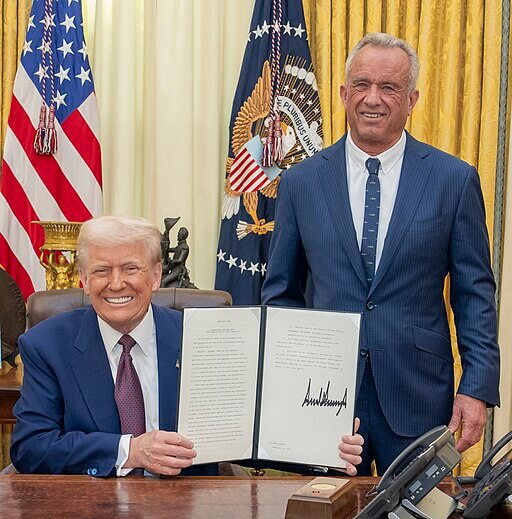
The U.S. food landscape is undergoing a dramatic transformation as Health and Human Services Secretary Robert F. Kennedy Jr. leads an aggressive campaign to eliminate petroleum-based synthetic dyes from the nation's food supply, describing the initiative as a response to what he terms a national health emergency. During a press conference on Tuesday, Kennedy, alongside FDA Commissioner Marty Makary and other health officials, outlined a comprehensive plan that marks one of the most significant food regulatory changes in decades.
The Synthetic Dyes Being Eliminated
The federal government is targeting a total of nine petroleum-based synthetic dyes currently approved for use in foods. These colorants, which provide the vibrant hues in many popular processed foods, have been placed on an accelerated removal schedule:
- Already Banned: Red Dye No. 3 (erythrosine) was banned by the FDA in January 2025 under the Biden administration due to evidence linking it to cancer in laboratory animals.
- Imminent Removal: Citrus Red No. 2 and Orange B will be the next to go, with the FDA initiating the revocation process within the coming months.
- Targeted for Phase-Out by End of 2026: Six additional synthetic dyes have been slated for elimination:
- FD&C Red No. 40 (Allura Red)
- FD&C Yellow No. 5 (Tartrazine)
- FD&C Yellow No. 6 (Sunset Yellow)
- FD&C Blue No. 1 (Brilliant Blue)
- FD&C Blue No. 2 (Indigo Carmine)
- FD&C Green No. 3
HHS Secretary Kennedy has been particularly vocal about the urgency of this initiative. "For too long, some food producers have been feeding Americans petroleum-based chemicals without their knowledge or consent," Kennedy said. "These poisonous compounds offer no nutritional benefit and pose real, measurable dangers to our children's health and development."
The Health Concerns Behind the Ban
The drive to eliminate synthetic dyes stems from mounting concerns about potential health impacts, particularly on children. FDA Commissioner Makary cited research linking these petroleum-derived colorants to several health conditions. "Studies have found a link between petroleum-based synthetic dyes and health conditions, including attention-deficit/hyperactivity disorder, obesity, diabetes, cancer and gastrointestinal issues," Makary stated at the press conference.
The California Office of Environmental Health Hazard Assessment conducted a review in 2021 that concluded consumption of some food dyes can result in hyperactivity and other neurobehavioral problems in certain children, though sensitivity varies among individuals. This research has been a significant driver behind the current regulatory action.
Kennedy highlighted alarming chronic disease rates in America as a key motivator. He noted the drastic increase in chronic diseases from 3% during his uncle's presidency to 60% today, and cited impacts on national readiness, with 74% of American youth deemed unfit for military service. These statistics, according to Kennedy, underscore the urgent need for immediate intervention in food additives.
"We don't have an agreement; we have an understanding." - HHS Secretary Kennedy
Industry Response and Implementation Timeline
The HHS and FDA approach involves a mixture of mandatory and voluntary measures. While Red Dye No. 3 must be removed from food by mid-January 2027 and from ingested drugs in 2028, officials are requesting that food companies accelerate this timeline. "The FDA is also taking steps to work with industry to eliminate six synthetic dyes – red No. 40, yellow No. 5, yellow No. 6, blue No. 1, blue No. 2 and green No. 3 – by the end of next year," according to the agency's announcement.
The implementation relies significantly on industry cooperation. Kennedy has reported positive engagement with major food manufacturers. Kennedy told reporters: "We don't have an agreement; we have an understanding." Last month, the HHS Secretary met with executives from major food companies including Tyson Foods, General Mills, Kraft Heinz, and representatives from the Consumer Brands Association to discuss the transition.
The National Confectioners Association, representing many manufacturers of candy and confections that heavily utilize these dyes, has indicated compliance with the new direction. "We follow and will continue to follow regulatory guidance from the authorities in this space, because consumer safety is our chief responsibility and priority," said Christopher Gindlesperger, senior vice president for public affairs and communications.
Natural Alternatives Being Fast-Tracked
To facilitate the transition away from synthetic dyes, the FDA has announced plans to fast-track the approval of natural colorants. "For companies that are currently using petroleum-based red dye, try watermelon juice or beet juice," FDA Commissioner Makary suggested. "For companies currently combining petroleum-based yellow chemical and red dyes together, try carrot juice."
The FDA will authorize four new food dyes derived from natural sources in the coming weeks, including calcium phosphate, Galdieria extract blue, gardenia blue, and butterfly pea flower extract, which can produce shades ranging from deep purple to bright blue. This accelerated approval process is designed to provide manufacturers with viable alternatives as they reformulate their products.
Products Affected and Consumer Impact
The elimination of these synthetic dyes will affect thousands of products across the American food landscape. According to the FDA, products that will need reformulation include "baked goods, cereals, ice cream, popsicles, frostings and icing, confections, beverages, candy, frozen dairy desserts, yogurt, condiments, gelatins, crackers, sauces, pudding, snack foods and more."
Consumers may notice changes in the appearance of many familiar products over the next 18 months. Natural colorants often produce less vibrant or slightly different hues compared to their synthetic counterparts. Additionally, products using natural colorants may experience shorter shelf life or require refrigeration in some cases.
Kennedy has emphasized international disparities in food standards as part of his argument for these changes. He pointed out that many American food products are already manufactured with different ingredients for international markets. For example, Froot Loops sold in Canada use vegetable dyes, while the U.S. version contains petroleum-based synthetics.
Broader "Make America Healthy Again" Initiative
This regulatory action represents just the first step in Kennedy's ambitious "Make America Healthy Again" (MAHA) agenda. "One by one we're going to get rid of every ingredient and additive in food that we can legally address," Kennedy promised.
The initiative includes partnerships with the National Institutes of Health to conduct comprehensive research on how food additives impact children's health and development. NIH Director Jay Bhattacharya is supporting this research effort, which aims to provide stronger scientific evidence for future regulatory decisions.
The drive for cleaner food ingredients aligns with a growing movement at the state level. In March, West Virginia Governor Patrick Morrisey signed one of the most sweeping dye ban bills in the country, and California has implemented its own restrictions on certain food dyes in schools.
Expert Opinions and Perspectives
The scientific community remains somewhat divided on the health impacts of synthetic food dyes. The FDA has previously acknowledged that while the "totality of scientific evidence" indicates most children have no adverse effects when consuming these dyes, some evidence suggests certain children may be sensitive to them.
Some experts caution that the evidence for health risks isn't entirely conclusive. Jamie Alan, an associate professor of pharmacology and toxicology at Michigan State University, takes a stronger stance, stating: "There is no benefit to synthetic dyes — other than profit — and there is no acceptable use for these."
The Center for Science in the Public Interest, a nonprofit that has long advocated for restrictions on food dyes, welcomed the move but expressed a preference for mandatory rather than voluntary measures. Thomas Galligan, principal scientist at CSPI, indicated he had hoped the FDA's announcement would be a ban on synthetic dyes, not a voluntary agreement to get the food industry to cooperate.
Looking Ahead
As the food industry begins the massive undertaking of reformulating thousands of products, consumers can expect to see gradual changes on supermarket shelves over the next 18-24 months. Companies will likely use this transition as an opportunity to promote their products as "free from artificial colors" and emphasize natural ingredients.
The elimination of synthetic dyes represents just the beginning of what Kennedy describes as a comprehensive strategy to tackle chronic disease and improve public health in the United States. With federal agencies taking decisive action and the food industry apparently on board, this initiative marks a significant shift in America's approach to food regulation and ingredient transparency.
Kennedy's message to consumers and the food industry was direct and uncompromising: "If they want want to eat petroleum, they ought to add it themselves at home." This bold stance signals that further regulatory changes in the American food supply may be on the horizon as the "Make America Healthy Again" agenda unfolds.
Sources: This article was compiled using information from multiple news outlets reporting on the FDA's synthetic food dye phase-out plan. Information was gathered from The Washington Post, CNN, ABC News, NBC News, NPR, Fox News, and Bloomberg, all of which covered Health and Human Services Secretary Robert F. Kennedy Jr.'s April 22, 2025 press conference. Additional details were sourced from the official FDA and HHS press releases. The article includes quotes from Kennedy, FDA Commissioner Marty Makary, industry representatives, and independent health experts as reported by these outlets. All information reflects announcements and reporting as of April 25, 2025.






